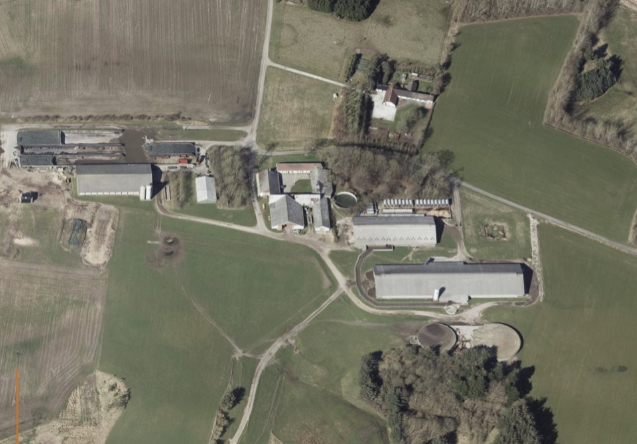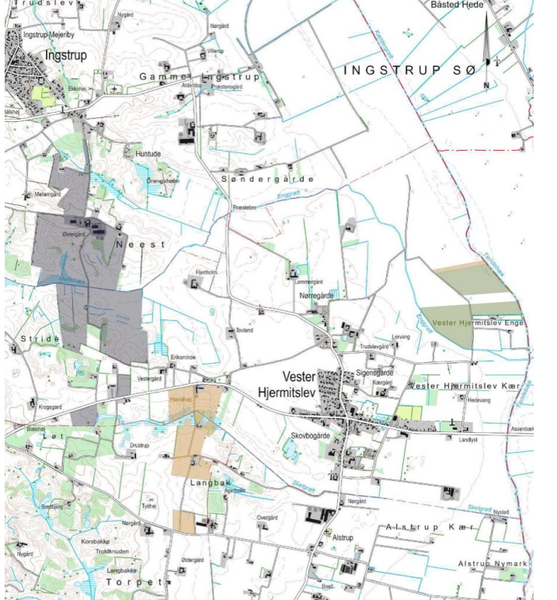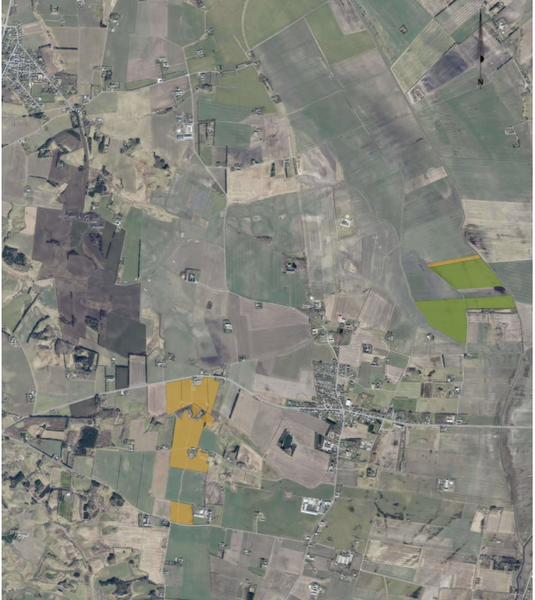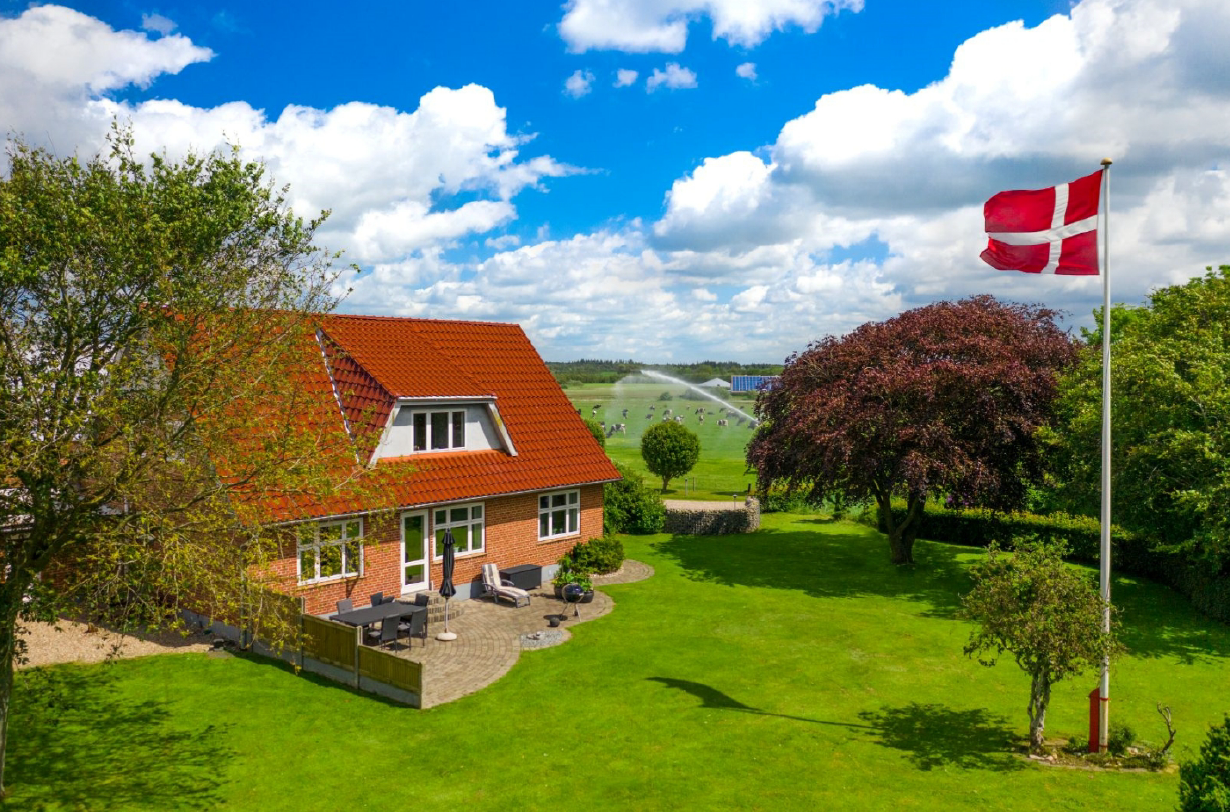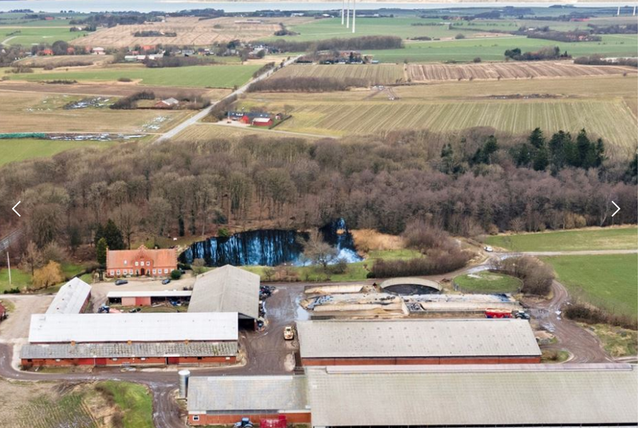Dairy farm in Løkken.
Noord Jutland, Denmark
Characteristics
Characteristics
Description
The Land
Previously, there were 4 robots on the site, but these have been removed. All heifers are outsourced to a farmer in Hobro and a farmer in Gl. Vittrup. Nowadays, there is a milking parlor in the oldest dairy barn. The property consists of 3 parts, the main building, one without a building, and one where a manure silo is placed.
The total area of the properties is 159.1161 ha. Of this, 121.11 ha. is arable land, 3.91 ha. pasture, 14.22 ha. Article 3, the rest is building land, etc. Part of the areas is very hilly. All properties are located near the main building. See area map in the presentation.
Machine House/Garage and Boiler Room
Building 5 was built in 1900/1980 and has an area of 300 m². There are steel trusses and part is used for machinery. Additionally, there is a double garage, workshop, and boiler room with changing rooms for the employees.
Barn
Old barn building 3 was built in 1900 and has an area of 260 m². The barn is ready for demolition, used for small circulation.
Old Stable
The stable buildings 2 and 6 were built in 1950/1980 and have a total area of 651 m². There are 23 boxes, as well as slatted floors and deep litter boxes. Feeding aisle in the middle. At the end of the building, there is a separate barn with straw storage.
Barn
Barn building 4 was built in 1974 and has an area of 500 m². Here are some small machines and machines used in daily operations.
Loose Barn
The stable building 8 was built in 1995 and has an area of 1,414 m². It is equipped with 140 boxes with mattresses and slatted floors behind them. There is a partially self-locking feed fence. Straw pens of 100 m². In the stable, there are 2 x 8 Delaval milking parlors side by side from 1998. Additionally, there is a calf kitchen, technical room, office, toilet. At both ends, there is a large gate. The cows from the other stable are driven up here and milked.
Calving Area
Outside the loose barn, there is a large area where there are 4 older pens used for calving pens, 39 elevated single boxes for calves, and 17 communal pens for larger calves.
Loose Barn
The stable building 9 was built in 2011 and has an area of 2,820 m². It is a former robot barn with space for 4 robots. The stable is equipped with a tank room with a buffer tank of 2,000 l. Outside there is a silo tank of 24,000 l. Folkloric spaces. The stable is divided into 4 sections each with 65 cubicles with waterbeds, there is a solid floor behind the cubicles where manure scrapers used to be. Large gate at both ends and wide feeding aisle. The cows from this stable are driven into the milking parlor via a ramp in the second loose drift. There is a requirement from the environmental authorities that manure scraper installations be reinstalled in the stables, alternatively, a new environmental permit is required.
Former Airplane Hangar
Building 7 was built in 1975 and has an area of 240 m². It is currently used for small machines. It has a gate at the end.
Feed Barn
Building 10 was built in 2011 and has a registered area of 1,300 m². It is used for various feed warehouses. Outside there are 2 large fiberglass silos.
Trench Silos
There are 5 silage silos outside the feed barn. The 2 are 10 m. wide, 32 m. long, and 2.8 m. high, additionally, there are 2 that are 10 m. wide and 72 m. long and 2.8 m. high. The last one is 14 m. wide and 72 m. long and 2.8 m. high. Between the silos is asphalt and in the west, there is a 15 m long space with asphalt after silage silos.
Water Basin
To the east of the feed barn, there is a basin for collecting surface water. This is directed through a pipeline to 2 sprinklers.
Residential House
The house was built in 1877 and has a living area of 210 m². Nicely furnished and decorated as follows, hall, living room, room, hallway, bathroom, living room, kitchen, hallway, room, bathroom, 2 rooms, bedroom, and back hallway.
.We strive to contact you within 48 hours.
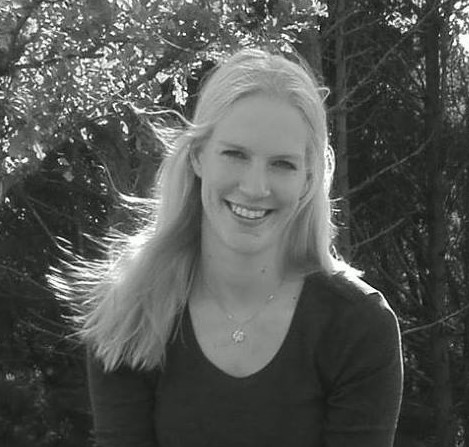
Denmark
Denmark is a country located in Northern Europe. It occupies most of the Jutland Peninsula and several islands, including Zealand, Funen, Lolland, Falster, and Bornholm. Denmark borders Germany to the south and is surrounded by the North Sea to the west and the Baltic Sea to the east.
Population
With an estimated population of approximately 5.8 million people, Denmark is one of the smaller countries in Europe in terms of population size. The capital and largest city of Denmark is Copenhagen, located on the island of Zealand, and it has about one and a half million inhabitants. The population of Denmark is generally very prosperous and enjoys a high standard of living. Currently, over 80% of the population lives in cities, and this number is expected to increase due to industrial growth. Most Dutch agricultural families live on the Jutland Peninsula. The Danes have a positive attitude toward the Dutch, especially because they integrate well.
Currency
The official currency of Denmark is the Danish krone (DKK). One krone is divided into one hundred øre. The Danish krone is used for all financial transactions in the country, and its exchange rate against other currencies is determined by financial markets.
Social affairs
Denmark is renowned for its comprehensive social security system, which focuses on the well-being of all citizens. The social system includes social assistance, healthcare, unemployment benefits, elderly care, and educational support. This extensive system contributes to equality and social cohesion in Danish society.
Education
The education system in Denmark is of high quality and offers equal opportunities for all children. It is based on a combination of public and private schools, with public schools being free and private schools often providing additional educational offerings. The education system includes preschool, primary school, secondary education, and higher education, with options for both academic and vocational training.
